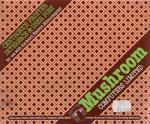
Electron User
 1st November 1984
1st November 1984
Categories: Review: Peripheral
Author: Barry Pickles
Publisher: Mushroom
Machine: Acorn Electron
Published in Electron User 2.02
Ask any micro user what extra facilities he desires and a printer is sure to be near the top of the list. The lack of a printer interface on the Electron must have put a number of potential users off the machine.
The Mushroom Centronics Printer Interface is one of several that have been produced to fill the gap and it also includes another useful device - a BBC-type 8 bit User Port.
Unpacking reveals a rather neat unit with an edge connector at one end and the normal Electron expansion connector at the other. Down the side are the printer and user port connections, these being exactly as those on the BBC Micro.
With the unit comes a four page instruction booklet and a tape containing the software necessary to run a printer.
The booklet tells you how to connect a printer in simple, easy to follow steps. The cable required is the same as that for a BBC Micro.
The software driver tape will assemble machine-code at any address in memory that you desire. It is a good idea to make several versions at various addresses and save them for use with different programs.
The other side of the tape contains a separate program, allowing you to print graphics screens. This program is for the Epson MX80, but should work with Epson-compatible printers such as the Shinwa.
Incidentally, you may feel that having to load a separate program to make the printer work is something of a nuisance, but really the assembled code loads in a matter of seconds and the advantage to doing it this way, instead of having the program in ROM, is that it makes the unit compatible with other expansions.
The other half of the unit contains the user port - basically, a device which enables the micro to communicate with the real world.
In this unit you have eight lines which can be set individually for input or output, plus two lines for handshaking. This is a fancy term for a system which makes sure that the micro and the device attached to it only transfer information when they are both ready.
As far as it goes, the booklet is clear in giving you instructions to use this port. However, it really doesn't go far enough for my liking.
The chip used to create these ports is the 6522, known as a Versatile Interface Adapter (VIA), which is the same as that used by the BBC Micro. It is quite a complex device but, if you take the trouble to master it, is extremely useful.
Applications include a switched-joystick interface, analogue/digital port, temperature controllers and plotters.
I appreciate that for Mushroom to include a treatise on its full use would have considerably increased the cost of producing the manual, but I do think that they could perhaps have pointed the user in the direction of a suitable reference.
I shall rectify this immediately by recommending a book that not only includes a detailed description of the 6522, but also gives you a number of applications to try - Interfacing Projects For The BBC Micro by Bruce Smith (Addison-Wesley, £6.95).
To use this book (or, indeed, any BBC application for the user port), all you have to remember is that the Mushroom interface maps the user port one page lower in memory. That is, any references to memory at &FExx in the Beeb should be changed to &FDxx for the Electron.
To sum up, this is a very nice unit, well constructed, and assuming that you are prepared to do your own research on the VIA can be definitely recommended.
Please experiment with the user port - it will open up whole new worlds.


